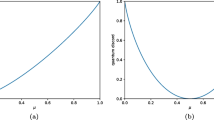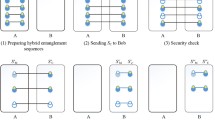Abstract
Information is encoded in a qubit in the form of its Bloch vector. In this paper, we propose protocols for remote transfers of information in a known and an unknown qubit to qudits using SU(2)-invariant \(2 \times N\)-level separable discordant states as quantum channels. These states have been identified as separable equivalents of the two-qubit entangled Werner states in Bharath and Ravishankar (Phys Rev A 89:062110, 2014). Due to \(SU(2) \times SU(2)\) invariance of these states, the remote qudit can be changed by performing appropriate measurements on the qubit. We also propose a protocol for transferring information of a family of unknown qudits to remote qudits using \(2 \times N\)-level states as channels. Finally, we propose a protocol for swapping of quantum discord from \(2\times N\)-level systems to \(N \times N\)-level systems. All the protocols proposed in this paper involve separable states as quantum channels.







Similar content being viewed by others
Notes
For \(S=20\), the equivalent state \(\frac{1}{2S+1}(\mathbb {1}+\frac{S_z}{S})\) (of a pure single-qubit state \(\frac{1}{2}(\mathbb {1}+\sigma _z)\)) has fidelity 0.876 with the completely mixed state \(\frac{1}{2S+1}\mathbb {1}\).
References
Bell, J.S.: On the Einstein Podolsky Rosen paradox. Physics 1, 195 (1964)
Horodecki, R., Horodecki, P., Horodecki, M., Horodecki, K.: Quantum entanglement. Rev. Mod. Phys. 81, 865–942 (2009)
Wiseman, H.M., Jones, S.J., Doherty, A.C.: Steering, entanglement, nonlocality, and the Einstein–Podolsky–Rosen paradox. Phys. Rev. Lett. 98, 140402 (2007)
Ollivier, H., Zurek, W.H.: Quantum discord: a measure of the quantumness of correlations. Phys. Rev. Lett. 88, 017901 (2001)
Bennett, C.H., Brassard, G., Crépeau, C., Jozsa, R., Peres, A., Wootters, W.K.: Teleporting an unknown quantum state via dual classical and Einstein–Podolsky–Rosen channels. Phys. Rev. Lett. 70, 1895–1899 (1993)
Bennett, C.H., Wiesner, S.J.: Communication via one- and two-particle operators on Einstein–Podolsky–Rosen states. Phys. Rev. Lett. 69, 2881–2884 (1992)
Bennett, C.H., DiVincenzo, D.P., Shor, P.W., Smolin, J.A., Terhal, B.M., Wootters, W.K.: Remote state preparation. Phys. Rev. Lett. 87, 077902 (2001)
Vazirani, U., Vidick, T.: Fully device-independent quantum key distribution. Phys. Rev. Lett. 113, 140501 (2014)
Żukowski, M., Zeilinger, A., Horne, M.A., Ekert, A.K.: “event-ready-detectors” bell experiment via entanglement swapping. Phys. Rev. Lett. 71, 4287–4290 (1993)
Popescu, S.: Bell’s inequalities versus teleportation: what is nonlocality? Phys. Rev. Lett. 72, 797–799 (1994)
Huang, Y.-F., Liu, B.-H., Liang Peng, Y.-H., Li, L.L., Li, C.-F., Guo, G.-C.: Experimental generation of an eight-photon Greenberger–Horne–Zeilinger state. Nat. Commun. 2(1), 1–6 (2011)
Monz, T., Schindler, P., Barreiro, J.T., Chwalla, M., Nigg, D., Coish, W.A., Harlander, M., Hänsel, W., Hennrich, M., Blatt, R.: 14-qubit entanglement: creation and coherence. Phys. Rev. Lett. 106, 130506 (2011)
Yao, X.-C., Wang, T.-X., Ping, X., He, L., Pan, G.-S., Bao, X.-H., Peng, C.-Z., Chao-Yang, L., Chen, Y.-A., Pan, J.-W.: Observation of eight-photon entanglement. Nat. Photonics 6(4), 225–228 (2012)
Dakić, B., Lipp, Y.O., Ma, X., Ringbauer, M., Kropatschek, S., Barz, S., Paterek, T., Vedral, V., Zeilinger, A., Brukner, Č., et al.: Quantum discord as resource for remote state preparation. Nat. Phys. 8(9), 666–670 (2012)
Madhok, V., Datta, A.: Quantum discord as a resource in quantum communication. Int. J. Mod. Phys. B 27(01n03), 1345041 (2013)
Fonseca, A.: High-dimensional quantum teleportation under noisy environments. Phys. Rev. A 100, 062311 (2019)
Perez-Garcia, B., McLaren, M., Goyal, S.K., Hernandez-Aranda, R.I., Forbes, A., Konrad, T.: Quantum computation with classical light: Implementation of the Deutsch–Jozsa algorithm. Phys. Lett. A 380(22–23), 1925–1931 (2016)
Perez-Garcia, B., Hernandez-Aranda, R.I., Forbes, A., Konrad, T.: The first iteration of Grover’s algorithm using classical light with orbital angular momentum. J. Mod. Opt. 65(16), 1942–1948 (2018)
Spreeuw, R.J.C.: Classical wave-optics analogy of quantum-information processing. Phys. Rev. A 63, 062302 (2001)
Goyal, S.K., Roux, F.S., Forbes, A., Konrad, T.: Implementing quantum walks using orbital angular momentum of classical light. Phys. Rev. Lett. 110, 263602 (2013)
Bharath, H.M., Ravishankar, V.: Classical simulation of entangled states. Phys. Rev. A 89, 062110 (2014)
Adhikary, S., Panda, I.K., Ravishankar, V.: Super-quantum states in su(2) invariant level systems. Ann. Phys. (2016)
Molina-Terriza, G., Juan, P.T., Lluis, T.: Twisted photons. Nat. Phys. 3(5), 305–310 (2007)
Erhard, M., Fickler, R., Krenn, M., Zeilinger, A.: Twisted photons: new quantum perspectives in high dimensions. Light Sci. Appl. 7(3), 17146–17146 (2018)
Radcliffe, J.M.: Some properties of coherent spin states. J. Phys. A Gen. Phys. 4(3), 313–323 (1971)
Werner, R.F.: Quantum states with Einstein–Podolsky–Rosen correlations admitting a hidden-variable model. Phys. Rev. A 40(8), 4277 (1989)
Nielsen, M.A., Chuang, I.L.: Quantum Information and Quantum Computation. Cambridge University Press, Cambridge, vol. 2(8), p. 23 (2000)
Bužek, V., Hillery, M.: Quantum copying: beyond the no-cloning theorem. Phys. Rev. A 54, 1844–1852 (1996)
Bock, M., Lenhard, A., Chunnilall, C., Becher, C.: Highly efficient heralded single-photon source for telecom wavelengths based on a ppln waveguide. Opt. express 24(21), 23992–24001 (2016)
Shen, Y., Wang, X., Xie, Z., Min, C., Fu, X., Liu, Q., Gong, M., Yuan, X.: Optical vortices 30 years on: Oam manipulation from topological charge to multiple singularities. Light Sci. Appl. 8(1), 1–29 (2019)
Padgett, M.J.: Orbital angular momentum 25 years on. Opt. Express 25(10), 11265–11274 (2017)
Ma, L., Xiaolong, S.: Remote transfer of gaussian quantum discord. Optics express 22(13), 15894–15903 (2014)
Xie, C., Liu, Y., Xing, H., Chen, J., Zhang, Z.: Quantum correlation swapping. Quantum Inf. Process. 14(2), 653–679 (2015)
Lütkenhaus, N., Calsamiglia, J., Suominen, K.-A.: Bell measurements for teleportation. Phys. Rev. A 59, 3295–3300 (1999)
Ghosh, S., Kar, G., Roy, A., Sen(De), A., Sen, U.: Distinguishability of bell states. Phys. Rev. Lett., 87:277902 (2001)
Calsamiglia, J.: Generalized measurements by linear elements. Phys. Rev. A 65, 030301 (2002)
Cao, C., Zhang, L., Han, Y.-H., Yin, P.-P., Fan, L., Duan, Y.-W., Zhang, R.: Complete and faithful hyperentangled-bell-state analysis of photon systems using a failure-heralded and fidelity-robust quantum gate. Optics express 28(3), 2857–2872 (2020)
Fan, L., Cao, C.: Deterministic cnot gate and complete bell-state analyzer on quantum-dot-confined electron spins based on faithful quantum nondemolition parity detection. JOSA B 38(5), 1593–1603 (2021)
Acknowledgements
It is a pleasure to thank Soumik Adhikary for discussions. We thank the anonymous referees, whose comments have really helped us improve the quality of the presentation and for bringing several relevant references to our attention. Sooryansh and Rajni thank CSIR (Grant no.: 09/086 (1278)/ 2017-EMR-I) and UGC for funding their research, respectively.
Author information
Authors and Affiliations
Contributions
All the authors have contributed equally in all respects.
Corresponding author
Additional information
Publisher's Note
Springer Nature remains neutral with regard to jurisdictional claims in published maps and institutional affiliations.
Appendices
Transfer of information from an unknown qubit to a remote qudit
Detailed calculations leading to Eqs. (22), (23), (24) and (25) are as follows. They essentially employ three properties, viz., tracelessness of Pauli matrices, \(\mathrm{Tr}(\varvec{\sigma }\cdot \hat{m}\varvec{\sigma }\cdot \hat{n}) = 2\hat{m}\cdot \hat{n}\), and, \(\mathrm{Tr}(A\otimes B)=\mathrm{Tr}(A)\mathrm{Tr}(B).\) It is sufficient to illustrate it for one case. The same method works for the other three equations as well.
We start with the case when Alice measures a singlet state out of the four Bell states, i.e. \(\rho _1^{AA}=\frac{1}{4}(\mathbb {1}-\varvec{{\sigma }_1} \cdot \varvec{\sigma }_2)\), which leads to equation (22), as follows:
which is the same as the equation (22).
Transfer of information from an unknown qudit to a remote qudit
When Alice measures \(\hat{S}_1\cdot \varvec{\sigma }_2\), she gets the states \(\dfrac{1}{2S+1}\Big (\mathbb {1}-\dfrac{\alpha }{3}\hat{S}_3\cdot \mathbf {p}\Big )\) and \(\dfrac{1}{2S+1}\Big (\mathbb {1}+\dfrac{\alpha }{3}\dfrac{S+1}{S}\hat{S}_3\cdot \mathbf {p}\Big )\) with respective probabilities of \(\frac{S+1}{2S+1}\) and \(\frac{S}{2S+1}\). The detailed calculations are as follows, which essentially employ the following two properties:
-
1.
The spin operators \(S_x, S_y, S_z\) are traceless, i.e. \(\mathrm{Tr}~ S_i=0\) and \(\mathrm{Tr}~ \sigma _j=0\), \(i, j \in {x, y, z}\).
-
2.
Trace of tensor product of two operators is equal to the product of the trace of operators, i.e. \(\mathrm{Tr}(A\otimes B)=\mathrm{Tr}(A)\mathrm{Tr}(B).\)
Case I When Alice’s state is projected into the eigenstate corresponding to the eigenvalue +1, which occurs with a probability \(\frac{S+1}{2S+1}\), then
The formula that we have used \(\mathrm{Tr}(\hat{S}_i\hat{S}_j) = \frac{(S+1)(2S+1)}{3S}\delta _{ij}\) can be proved as follows. We have
Taking trace of both sides and employing the property that \(\mathrm{Tr}S_x^2 = \mathrm{Tr}S_y^2 = \mathrm{Tr}S_z^2\), we obtain
Similarly, \(\mathrm{Tr}S_y^2 = \mathrm{Tr}S_z^2 = \frac{S(S+1)(2S+1)}{3}\). Furthermore, we have the following expression of invariance of trace under a unitary transformation,
where U is a unitary transformation. Consider a rotation about the X axis such that \(\hat{y} \rightarrow -\hat{y}\) and \(\hat{z}\rightarrow -\hat{z}\). Thus, under the effect of this transformation
Both of these results can be combined to the following equation:
Case II When Alice’s state is projected to the eigenstate corresponding to the eigenvalue \(-\frac{S+1}{S}\), which occurs with a probability \(\frac{S}{2S+1}\), then
This result is calculated following the same methodology as done for the Case I.
Swapping of quantum discord
In this appendix, we present those cases of swapping of quantum discord, proposed in Sect. (3.4), in which the remaining three Bell states are measured. The calculations for rest of the three projection operators of Bell basis are as follows. They essentially employ three properties, viz., tracelessness of Pauli matrices, \(\mathrm{Tr}(\varvec{\sigma }\cdot \hat{m}\varvec{\sigma }\cdot \hat{n}) = 2\hat{m}\cdot \hat{n}\), and, \(\mathrm{Tr}(A\otimes B)=\mathrm{Tr}(A)\mathrm{Tr}(B).\)
-
1.
When the measurement of \(\dfrac{1}{4}\Big (\mathbb {1}-({\sigma }_{1x}{\sigma }_{4x}-{\sigma }_{1y}{\sigma }_{4y}-{\sigma }_{1z}{\sigma }_{4z})\Big )\) is made, the post-measurement state is
$$\begin{aligned}&\mathrm{Tr}_{14}\dfrac{1}{2^4(2S+1)^2}\Big \{\Big (\mathbb {1}-({\sigma }_{1x}{\sigma }_{4x}-{\sigma }_{1y}{\sigma }_{4y}-{\sigma }_{1z}{\sigma }_{4z})\Big )(\mathbb {1}-\alpha {\varvec{\sigma }_1}\cdot \hat{S}_2)\nonumber \\&\qquad (\mathbb {1}-\beta \hat{S}_3\cdot \varvec{\sigma }_4)\Big \}\nonumber \\&\quad =\dfrac{1}{2^4(2S+1)^2}\mathrm{Tr}_{14}\Big (\mathbb {1}-\alpha \beta \varvec{\sigma }_{1}\cdot \hat{S}_2({\sigma }_{1x}{\sigma }_{4x}-{\sigma }_{1y}{\sigma }_{4y}-{\sigma }_{1z}{\sigma }_{4z})\hat{S}_3\cdot \varvec{\sigma }_4\Big )\nonumber \\&\quad =\dfrac{1}{2^4(2S+1)^2}\mathrm{Tr}_{14}\Big (\mathbb {1} -\alpha \beta \varvec{\sigma }_{1}\cdot \hat{S}_2({\sigma }_{1x}{\sigma }_{4x}\hat{S_{3x}} \sigma _{4x}\nonumber \\&\qquad +\,\sigma _{1x}{\sigma }_{4x}\hat{S}_{3y}\sigma _{4y} +\sigma _{1x}{\sigma }_{4x}\hat{S}_{3z}\sigma _{4z}\nonumber \\&\qquad - {\sigma }_{1y}{\sigma }_{4y}\hat{S}_{3x}\sigma _{4x}-{\sigma }_{1y}{\sigma }_{4y}\hat{S}_{3y}\sigma _{4y}-{\sigma }_{1y}{\sigma }_{4y}\hat{S}_{3z}\sigma _{4z}-{\sigma }_{1z}{\sigma }_{4z}\hat{S}_{3x}\sigma _{4x}\nonumber \\&\qquad - {\sigma }_{1z}{\sigma }_{4z}\hat{S}_{3y}\sigma _{4y}-{\sigma }_{1z}{\sigma }_{4z}\hat{S}_{3z}\sigma _{4z}\Big )\nonumber \\&\quad =\dfrac{1}{2^4(2S+1)^2}\mathrm{Tr}_{1}\Big (2\mathbb {1}-\alpha \beta \varvec{\sigma }_{1}\cdot \hat{S}_2({2\sigma }_{1x}\hat{S}_{3x}-2{\sigma }_{1y}\hat{S}_{3y}-2{\sigma }_{1z}\hat{S}_{3z}\Big )\nonumber \\&\quad =\dfrac{1}{2^3(2S+1)^2}\mathrm{Tr}_{1}\Big (\mathbb {1}-\alpha \beta \varvec{\sigma }_{1}\cdot \hat{S}_2({\sigma }_{1x}\hat{S}_{3x}-{\sigma }_{1y}\hat{S}_{3y}-{\sigma }_{1z}\hat{S}_{3z}\Big )\nonumber \\&\quad =\dfrac{1}{2^3(2S+1)^2}\mathrm{Tr}_{1}\Big (\mathbb {1}-\alpha \beta (\sigma _{1x}\hat{S}_{2x}({\sigma }_{1x}\hat{S}_{3x} -{\sigma }_{1y}\hat{S}_{3y}-{\sigma }_{1z}\hat{S}_{3z})\nonumber \\&\qquad +\,\sigma _{1y}\hat{S}_{2y}({\sigma }_{1x}\hat{S}_{3x}-{\sigma }_{1y}\hat{S}_{3y} -{\sigma }_{1z}\hat{S}_{3z})\nonumber \\&\qquad +\,\sigma _{1z}\hat{S}_{2z}({\sigma }_{1x}\hat{S}_{3x}-{\sigma }_{1y}\hat{S}_{3y}-{\sigma }_{1z}\hat{S}_{3z})\Big )\nonumber \\&\quad =\dfrac{1}{2^3(2S+1)^2}\mathrm{Tr}_{1}\Big (\mathbb {1}-\alpha \beta (\sigma _{1x}\hat{S}_{2x}({\sigma }_{1x}\hat{S}_{3x}-{\sigma }_{1y}\hat{S}_{3y}-{\sigma }_{1z}\hat{S}_{3z})\nonumber \\&\qquad +\,\sigma _{1y}\hat{S}_{2y}({\sigma }_{1x}\hat{S}_{3x}-{\sigma }_{1y}\hat{S}_{3y}-{\sigma }_{1z}\hat{S}_{3z})+\sigma _{1z}\hat{S}_{2z}({\sigma }_{1x}\hat{S}_{3x}-{\sigma }_{1y}\hat{S}_{3y}-{\sigma }_{1z}\hat{S}_{3z})\Big )\nonumber \\&\quad =\dfrac{1}{2^3(2S+1)^2}\Big (2\mathbb {1}-\alpha \beta (2\hat{S}_{2x}\hat{S}_{3x}-2\hat{S}_{2y}\hat{S}_{3y}-2\hat{S}_{3z}\hat{S}_{3z})\Big )\nonumber \\&\quad =\dfrac{1}{4}\times \dfrac{1}{(2S+1)^2}\Big (\mathbb {1}-\frac{\alpha \beta }{S^2}(S_{2x}S_{3x}-S_{2y}S_{3y}-S_{2z}S_{3z})\Big ). \end{aligned}$$(47)The factor of \(\frac{1}{4}\) represents the probability with which this state is prepared. Other calculations are performed using the same approach.
-
2.
When the measurement of \(\dfrac{1}{4}\Big (\mathbb {1}-(-{\sigma }_{1x}{\sigma }_{4x}-{\sigma }_{1y}{\sigma }_{4y}+{\sigma }_{1z}{\sigma }_{4z})\Big )\) is made
$$\begin{aligned}&\mathrm{Tr}_{14}\dfrac{1}{2^4(2S+1)^2}\Big \{\Big (\mathbb {1}-(-{\sigma }_{1x}{\sigma }_{4x}-{\sigma }_{1y}{\sigma }_{4y}+{\sigma }_{1z}{\sigma }_{4z})\Big )\nonumber \\&\qquad \times (\mathbb {1}-\alpha {\varvec{\sigma }_1} \cdot \hat{S}_2)(\mathbb {1}-\beta \hat{S}_3\cdot \varvec{\sigma }_4)\Big \}\nonumber \\&\quad =\dfrac{1}{2^4(2S+1)^2}\mathrm{Tr}_{14}\Big (\mathbb {1}-\alpha \beta \varvec{\sigma }_{1}\cdot \hat{S}_2(-{\sigma }_{1x}{\sigma }_{4x}-{\sigma }_{1y}{\sigma }_{4y}+{\sigma }_{1z}{\sigma }_{4z})\hat{S}_3\cdot \varvec{\sigma }_4\Big )\nonumber \\&\quad =\dfrac{1}{4}\times \dfrac{1}{(2S+1)^2}\Big (\mathbb {1}-\frac{\alpha \beta }{S^2}(-S_{2x}S_{3x}-S_{2y}S_{3y}+S_{2z}S_{3z})\Big ). \end{aligned}$$(48)The factor of \(\frac{1}{4}\) represents the probability with which this state is prepared.
-
3.
When the measurement of \(\dfrac{1}{4}\Big (\mathbb {1}-(-{\sigma }_{1x}{\sigma }_{4x}+{\sigma }_{1y}{\sigma }_{4y}-{\sigma }_{1z}{\sigma }_{4z})\Big )\) is made
$$\begin{aligned}&\mathrm{Tr}_{14}\dfrac{1}{2^4(2S+1)^2} \Big \{\Big (\mathbb {1}-(-{\sigma }_{1x}{\sigma }_{4x}+{\sigma }_{1y}{\sigma }_{4y}-{\sigma }_{1z}{\sigma }_{4z})\Big )(\mathbb {1}-\alpha {\varvec{\sigma }_1}\cdot \hat{S}_2)\nonumber \\&\qquad (\mathbb {1}-\beta \hat{S}_3\cdot \varvec{\sigma }_4)\Big \}\nonumber \\&\quad =\dfrac{1}{2^4(2S+1)^2}\mathrm{Tr}_{14}\Big (\mathbb {1}-\alpha \beta \varvec{\sigma }_{1}\cdot \hat{S}_2(-{\sigma }_{1x}{\sigma }_{4x}+{\sigma }_{1y}{\sigma }_{4y}-{\sigma }_{1z}{\sigma }_{4z})\hat{S}_3\cdot \varvec{\sigma }_4\Big )\nonumber \\&\quad =\dfrac{1}{4}\times \dfrac{1}{(2S+1)^2}\Big (\mathbb {1}-\frac{\alpha \beta }{S^2}(-S_{2x}S_{3x}+S_{2y}S_{3y}-S_{2z}S_{3z})\Big ). \end{aligned}$$(49)The factor of \(\frac{1}{4}\) represents the probability with which this state is prepared.
Rights and permissions
About this article
Cite this article
Asthana, S., Bala, R. & Ravishankar, V. Quantum communication with SU(2) invariant separable \(2\times N\) level systems. Quantum Inf Process 21, 35 (2022). https://doi.org/10.1007/s11128-021-03358-9
Received:
Accepted:
Published:
DOI: https://doi.org/10.1007/s11128-021-03358-9




